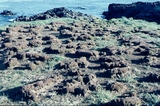
Antarctic Legacy Archive
Do plant-plant interactions affect functional traits? A case study of the sub-Antarctic cushion plant Azorella selago and the grass Agrostis magellanica
- ALSA Home
- →
- Documents
- →
- Research: Events, Presentations, Posters
- →
- View Item
JavaScript is disabled for your browser. Some features of this site may not work without it.
| dc.contributor.author | Van der Merwe, S. | |
| dc.contributor.author | Greve, M. | |
| dc.contributor.author | Le Roux, P.C. | |
| dc.coverage.spatial | sub-Antarctic | |
| dc.coverage.spatial | Marion Island | |
| dc.date.accessioned | 2021-03-10T14:47:06Z | |
| dc.date.available | 2021-03-10T14:47:06Z | |
| dc.date.created | 2016/07/27 | |
| dc.date.issued | 2016/07/27 | |
| dc.identifier.uri | http://hdl.handle.net/123456789/28672 | |
| dc.description.abstract | Plant-plant interactions may strongly affect population and community dynamics and can be key determinants of species distributions. Despite this, little research has focused on how interspecific interactions between plants affect the expression of functional traits, which in turn can influence community composition. Cushion plants are good model systems for the study of ecological interactions because, as ecosystem engineers, they modify their immediate microhabitat. Where these modifications decrease abiotic stress, cushion plants promote survival of beneficiary species. This engineering effect is particularly pronounced in abiotically-extreme environments, including in polar and alpine habitats. At moderate and high elevations on Marion Island, the cushion-forming Azorella selago has strong facilitative interactions with beneficiary species, especially through sheltering from harsh winds and protection from moving sediment. Here we test if interacting with A. selago affects the functional traits of the widespread grass species, Agrostis magellanica. Seven functional traits of A. magellanica were measured for individual grasses growing on A. selago cushion plants and in adjacent open ground, across four different elevations in exposed fellfield. Preliminary results for three traits show that this plant-plant interaction has a limited impact on functional trait expression in A. magellanica. Leaf dry matter content was significantly higher in grasses growing on A. selago, and also differed between elevations. In contrast, chlorophyll content and leaf toughness did not differ between grasses growing in the presence and absence of A. selago. Therefore, while A. selago has been shown to positively affect the size and reproductive effort of A. magellanica, these results show that the mechanism by which A. selago facilitates A. magellanica may not be through its impacts on functional trait expression. Thus, contrary to expect at ions, functional traits may not be as sensitive to biotic interactions as population and community characteristics. | en_ZA |
| dc.description.sponsorship | Sponsored by the the Department of Science and Innovation(DSI) through National Research Foundation (NRF) - South Africa | en_ZA |
| dc.description.statementofresponsibility | Antarctic Legacy of South Africa | en_ZA |
| dc.format | en_ZA | |
| dc.language | English | en_ZA |
| dc.publisher | South African National Antarctic Programme (SANAP) | en_ZA |
| dc.relation | SANAP Symposium 2016 | en_ZA |
| dc.rights | Copyright | en_ZA |
| dc.subject | Research | en_ZA |
| dc.subject | Science | en_ZA |
| dc.subject | Meetings | en_ZA |
| dc.subject | Symposium | en_ZA |
| dc.subject | SANAP Symposium 2016 | en_ZA |
| dc.subject | sub-Antarctic | en_ZA |
| dc.subject | Marion Island | en_ZA |
| dc.subject | Living Systems | en_ZA |
| dc.subject | Terrestrial Science | en_ZA |
| dc.subject | Research | en_ZA |
| dc.subject | Botany | en_ZA |
| dc.subject | Flora | en_ZA |
| dc.subject | Vascular Species | en_ZA |
| dc.subject | Cushion Plants | en_ZA |
| dc.subject | Azorella selago | en_ZA |
| dc.subject | Grasses | en_ZA |
| dc.subject | Agrostis magellanica | en_ZA |
| dc.subject | Species Distributions | en_ZA |
| dc.subject | Plant Functional Traits | en_ZA |
| dc.subject | Biological sciences | en_ZA |
| dc.title | Do plant-plant interactions affect functional traits? A case study of the sub-Antarctic cushion plant Azorella selago and the grass Agrostis magellanica | en_ZA |
| dc.type | Presentation-Abstracts | en_ZA |
| dc.rights.holder | Antarctic Legacy of South Africa | en_ZA |
| dc.rights.holder | Van der Merwe, S. | en_ZA |
| dc.rights.holder | Greve, M. | en_ZA |
| dc.rights.holder | Le Roux, P.C. | en_ZA |
| iso19115.mdconstraints.uselimitation | This item and the content of this website are subject to copyright protection. Reproduction of the content, or any part of it, other than for research, academic or non-commercial use is prohibited without prior consent from the copyright holder. | en_ZA |
| iso19115.mddistributor.distributorcontact | South African National Antarctic Programme (SANAP) | en_ZA |
| iso19115.mdformat.name | en_ZA | |
| iso19115.mdidentification.deliverypoint | Antarctic Legacy of South Africa, Faculty of Science, Private Bag X1, Matieland. Stellenbosch. South Africa. | en_ZA |
| iso19115.mdidentification.electronicmailaddress | antarcticlegacy@sun.ac.za | en_ZA |
| iso19115.mdidentification.organizationname | University of Pretoria | en_ZA |
Files in this item
This item appears in the following Collection(s)
-
Research: Events, Presentations, Posters [480]
Material directly related to official scientific and research events



